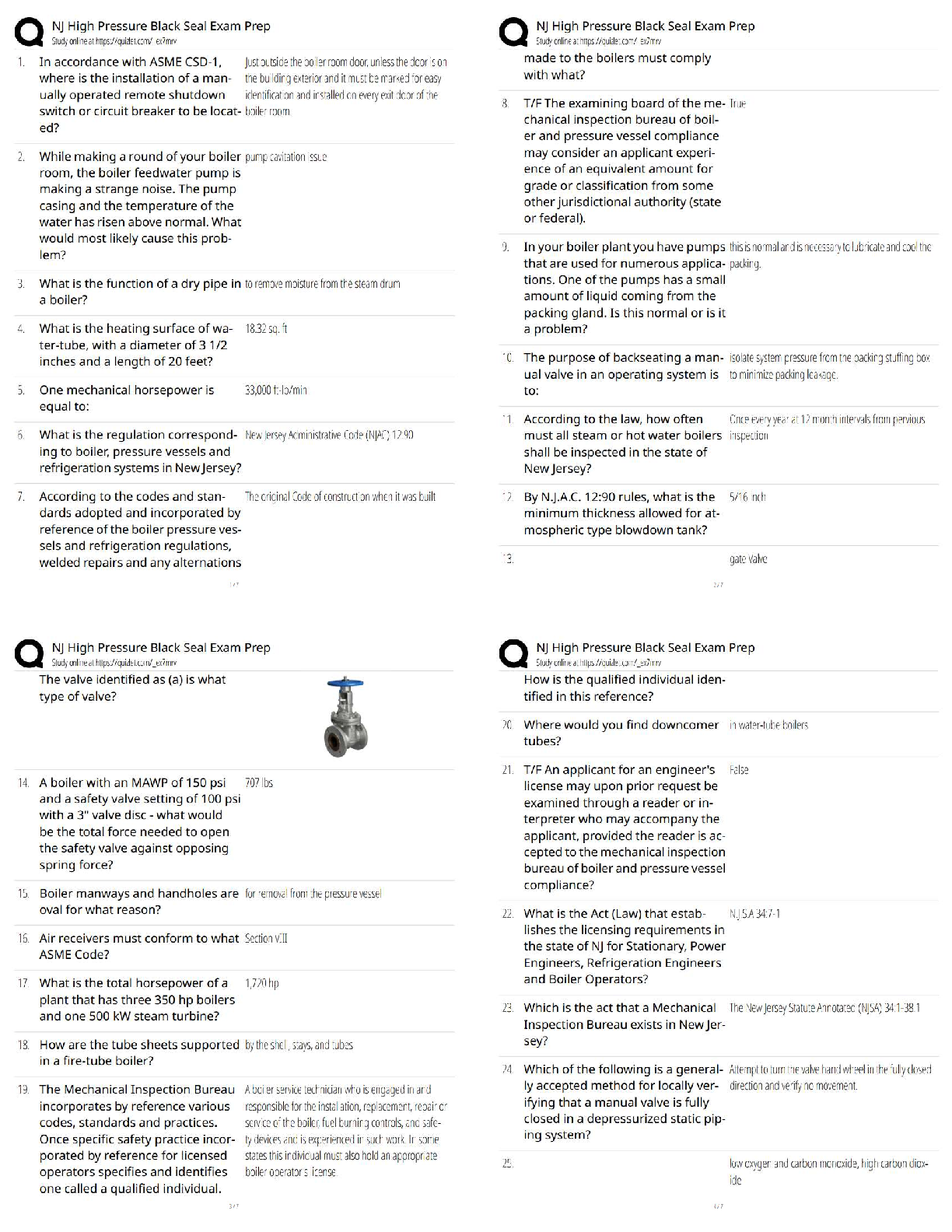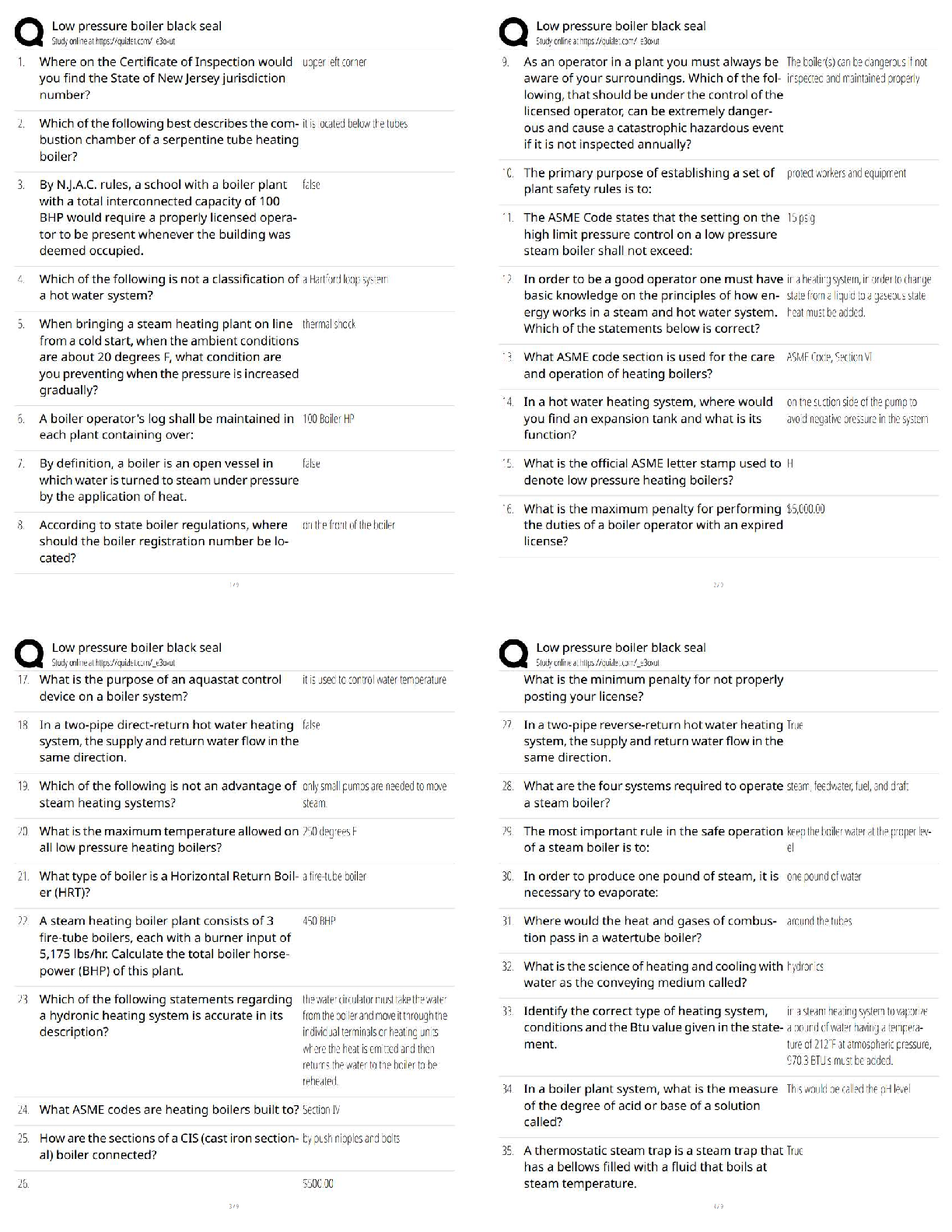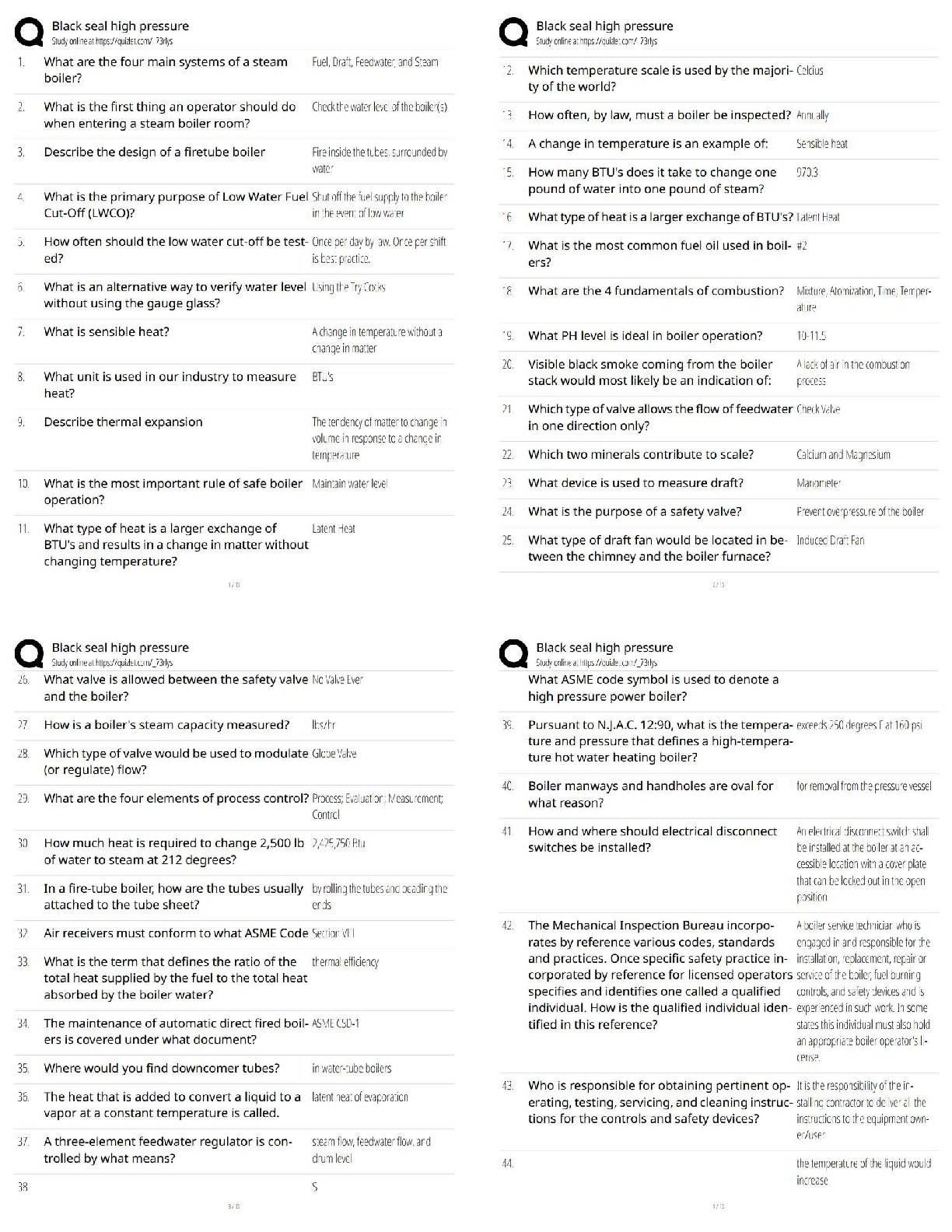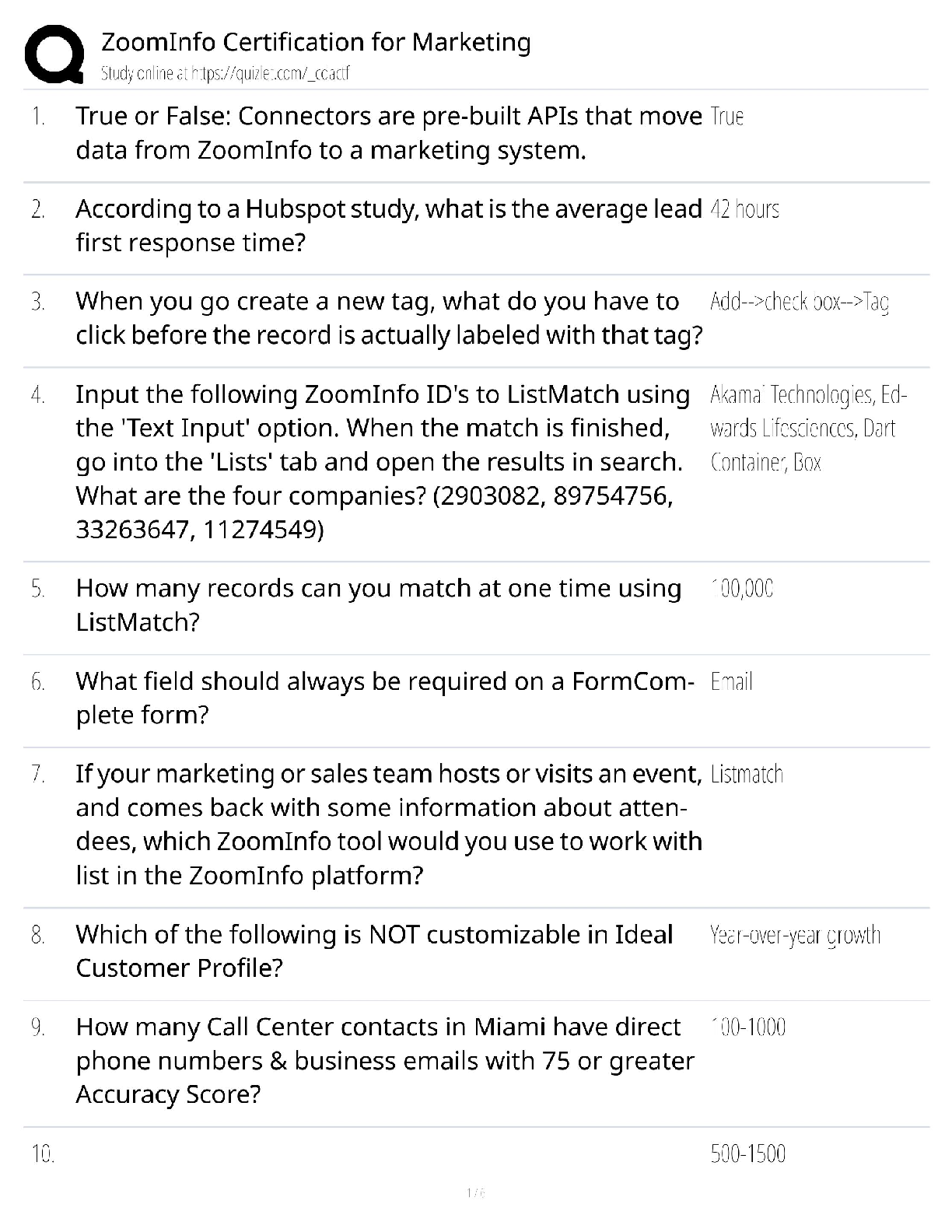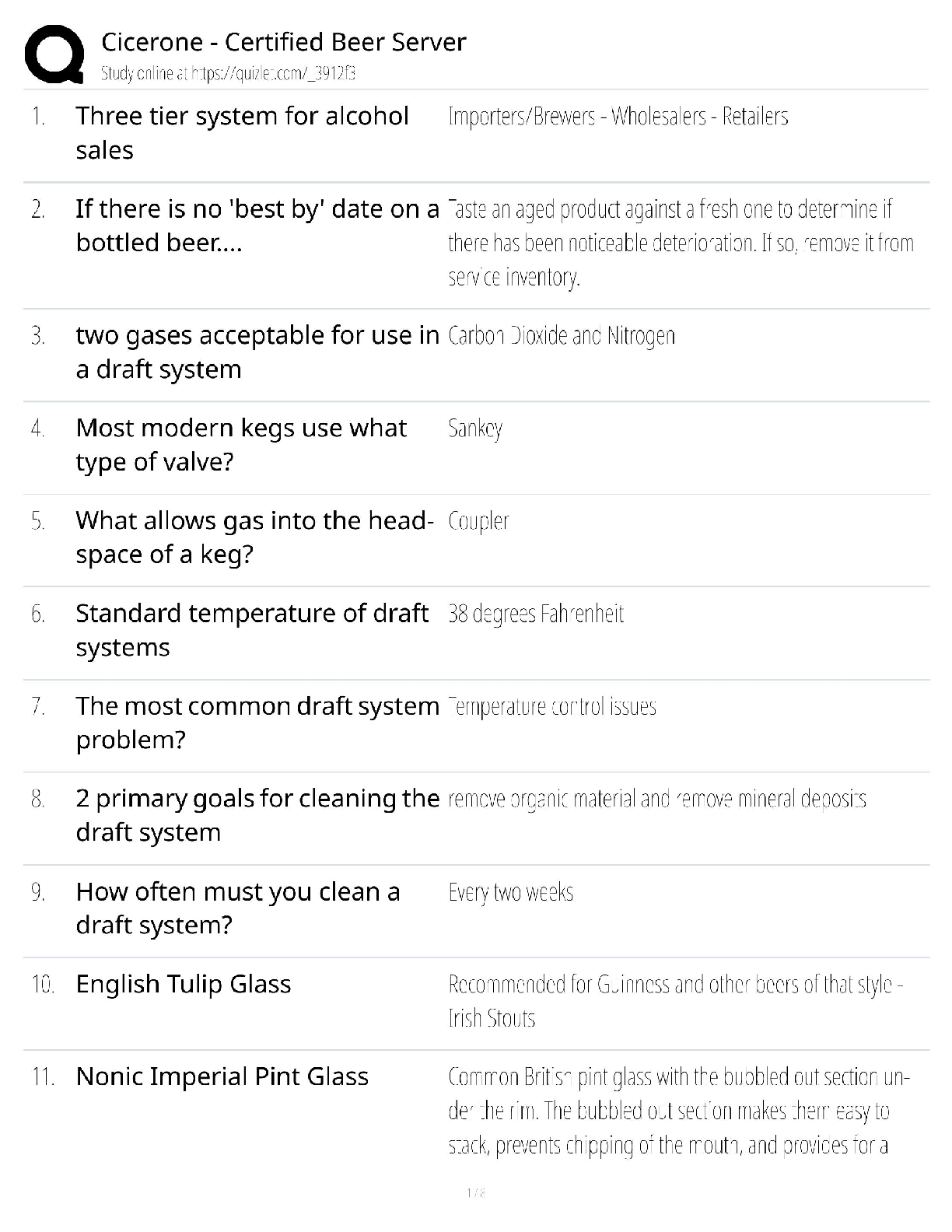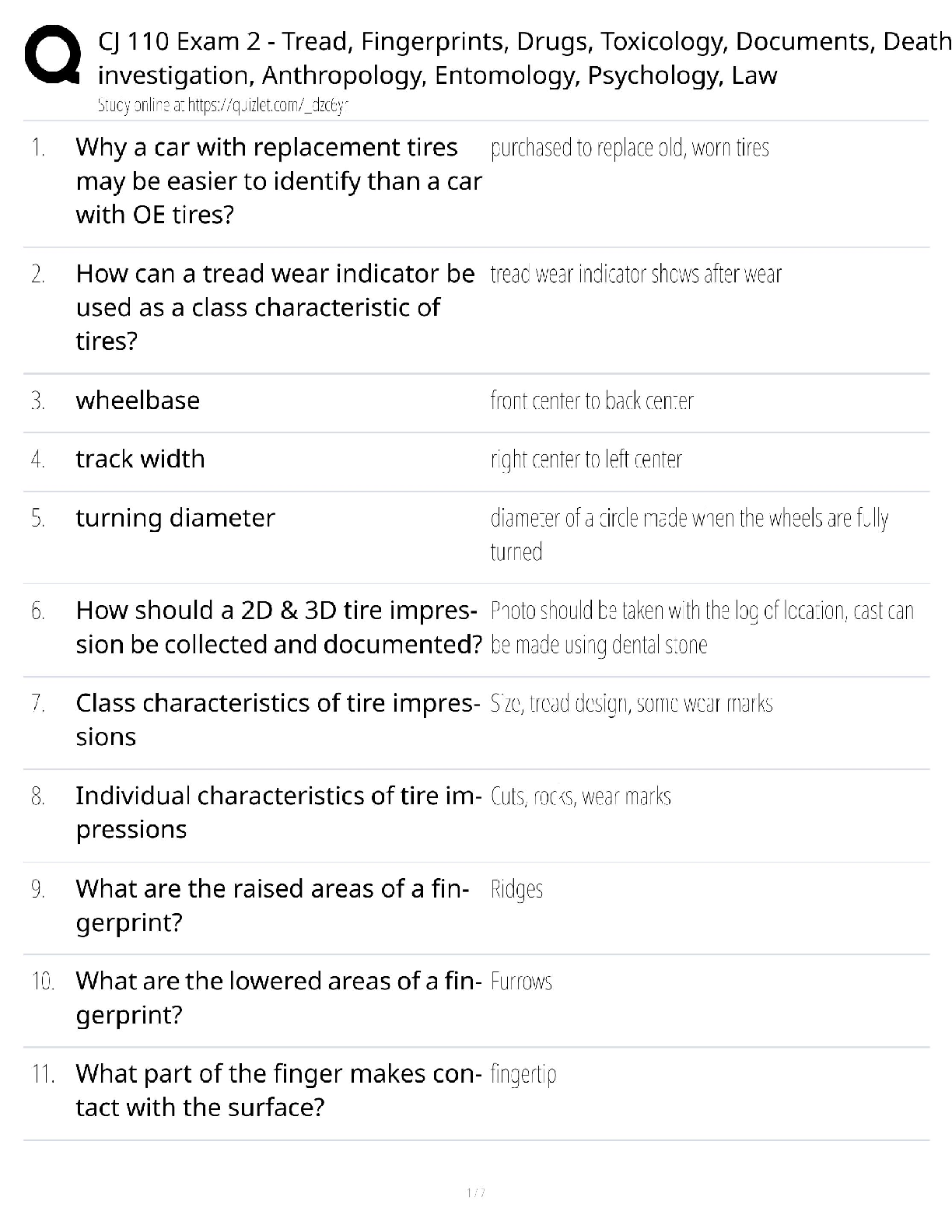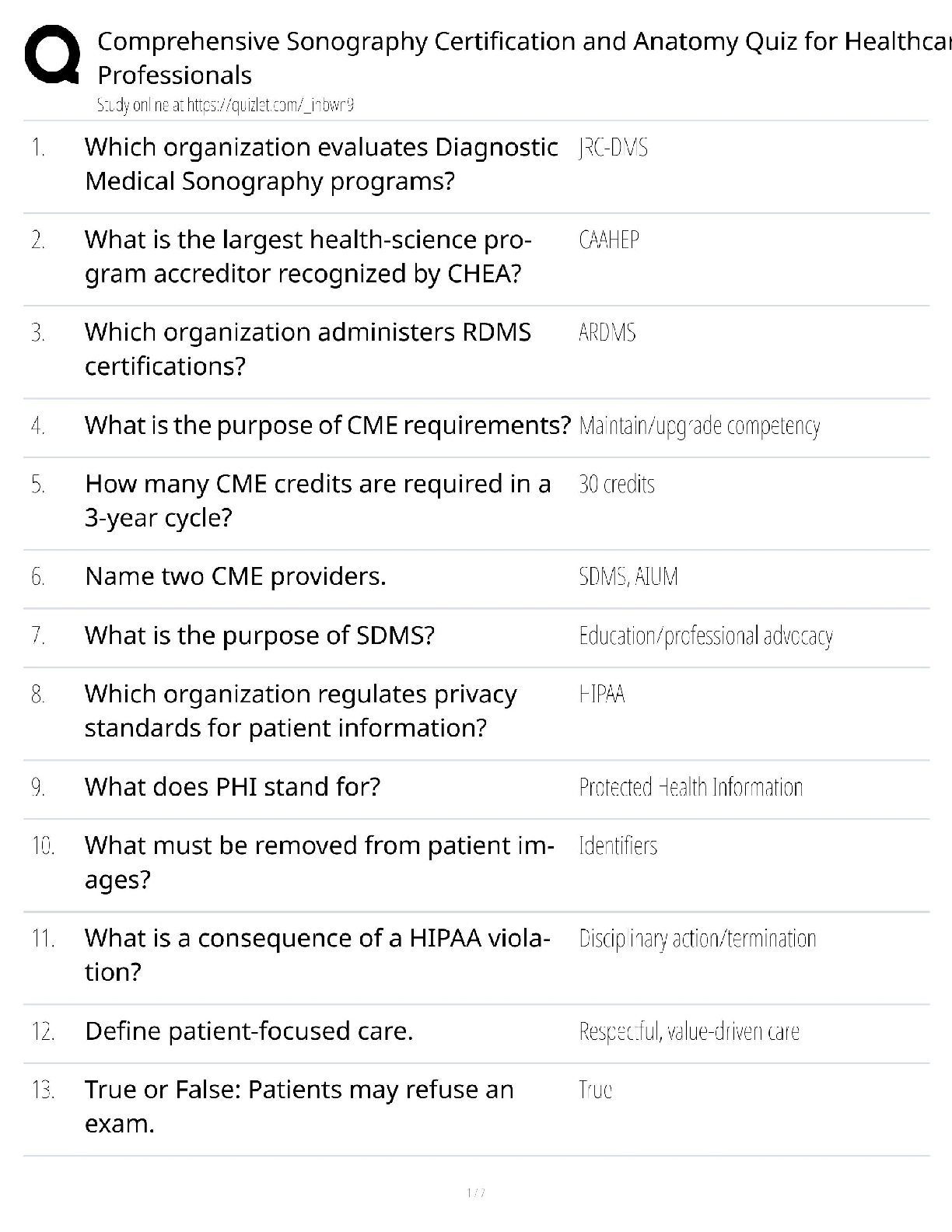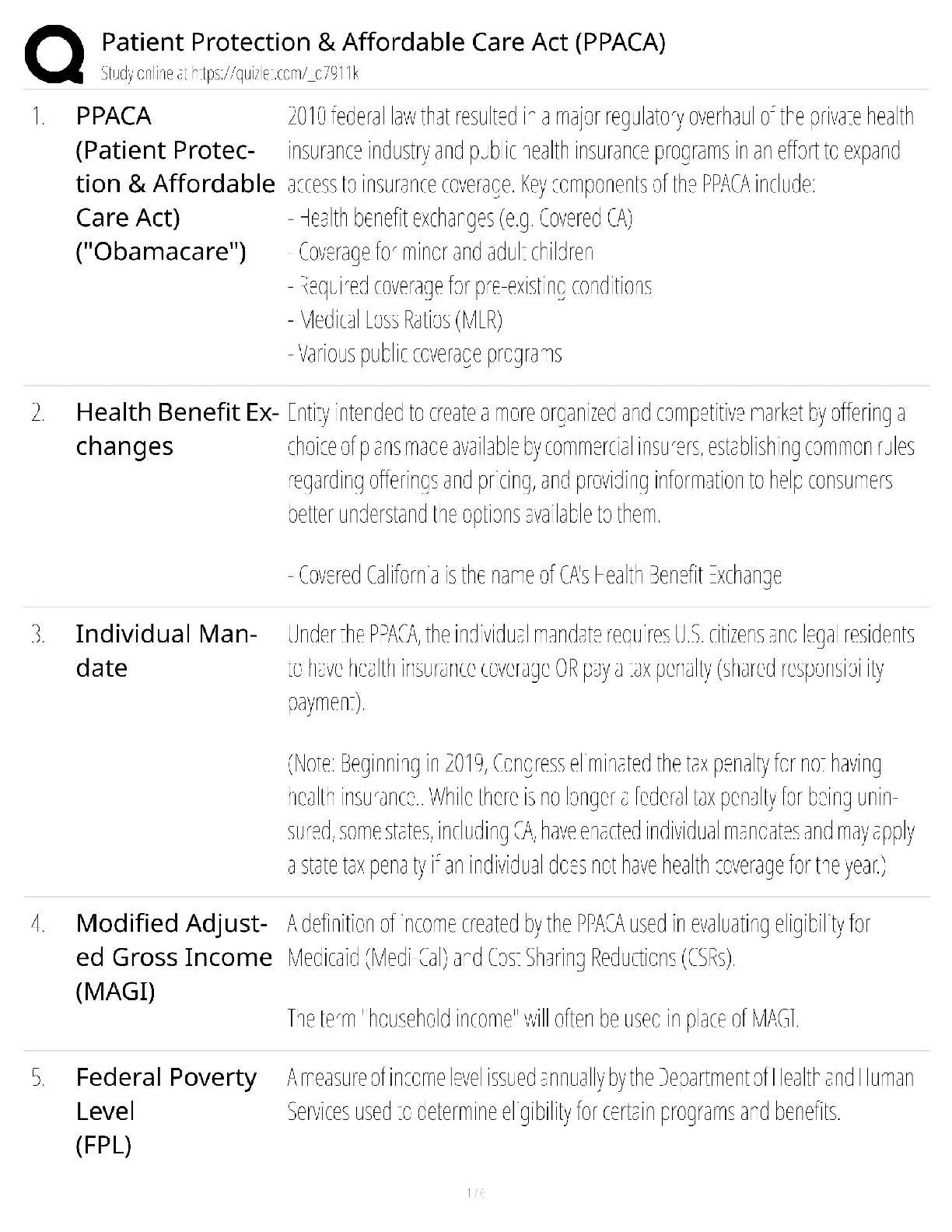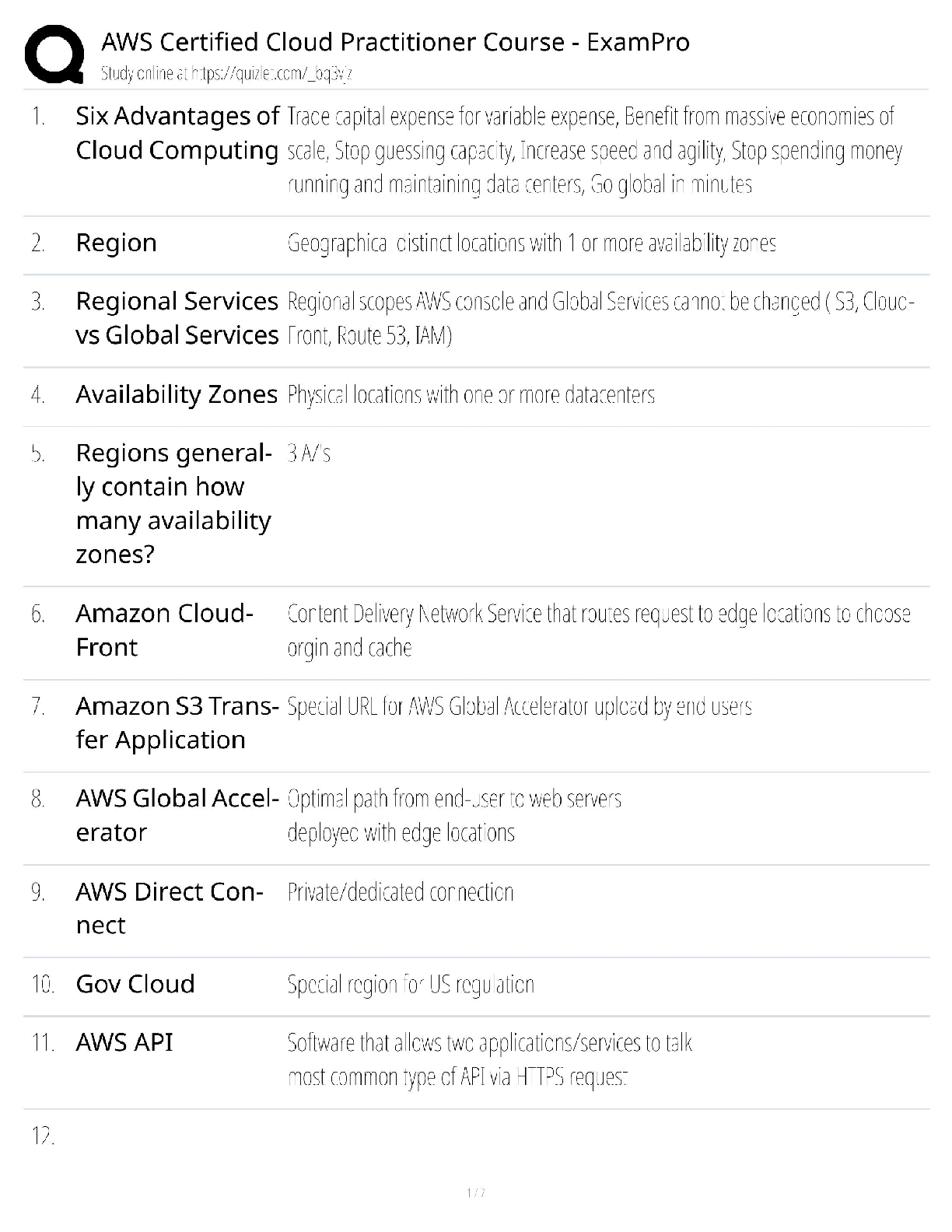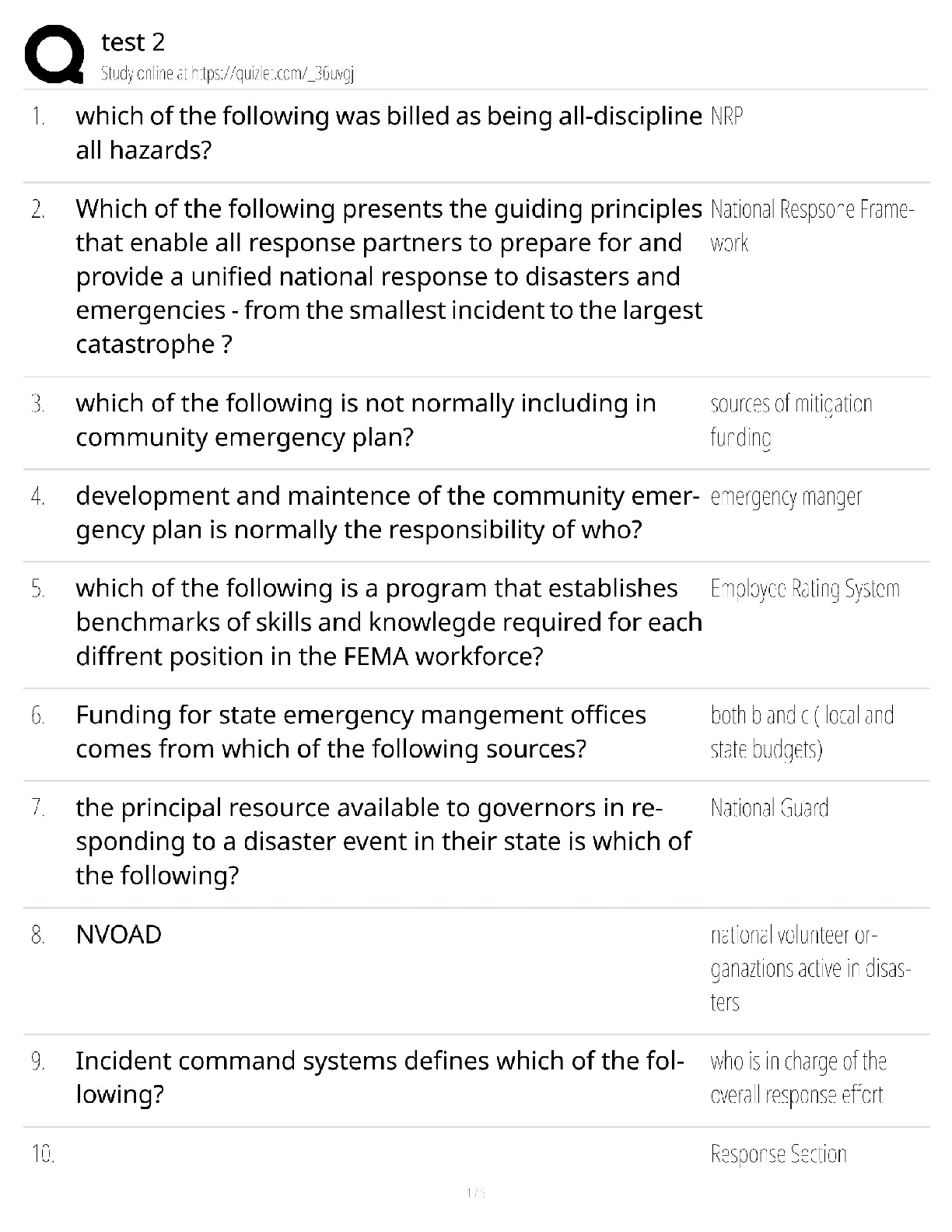*NURSING > QUESTIONS & ANSWERS > NSG 6420 WEEK 2 QUIZ (100% CORRECT SOLVED EXAM)/ Download To Score An A. (All)
NSG 6420 WEEK 2 QUIZ (100% CORRECT SOLVED EXAM)/ Download To Score An A.
Document Content and Description Below
NSG 6420 WEEK 2 QUIZ A patient has presented with an acute otitis externa and an oral temperature of 99 degrees. The nurse practitioner orders a complete blood count based on what possible risks fa ... ctor for otitis externa? Question 1 options: A patient’s diabetic or pre-diabetic state. <Urine and blood glucose tests are used to determine a patient’s potential for diabetes.> A previously diagnosed trauma to ear canal based on obstruction or vigorous cleaning. <Previous unrelated trauma would not incline a patient to future infection.> The patient has been exposed to a contagious viral disease or is not able to provide up-to-date immunization records. <The patient represents an immunocompromised population.> The patient presents with obstructed tympanic membrane (TM). <Visual obstructions are not initially diagnosed through Complete Blood Count.> A patient complains of tinnitus, swelling along the jawline, otalgia and a drainage in the throat. The patient reports frequent swimming in the days and weeks prior. What is the most likely diagnosis? Question 2 options: Sinusitis <Sinusitis is characterized by swelling or inflammation of the sinuses or the hollow cavities within the skull.> Rhinitis <Rhinitis (or coryza) is characterized by swelling, inflammation or irritation of the mucous membranes in the nasal cavity.> Pharyngitis <Pharyngitis is characterized by the swelling, inflammation or irritation of the throat.> Otitis <Otitis is characterized by the swelling, inflammation or irritation of the ears. Patient’s self-reported history of activity would contribute to the diagnosis.> Which of the following conditions would be considered a common EENT Disorder? Question 3 options: Rhinitis <Rhinitis is characterized by inflammation and swelling of the mucous membranes in the nose.> Influenza <Influenza is a respiratory illness caused by the influenza virus.> Alpha thalassemia <Alpha thalassemia is a hematologic condition which reduces the production of hemoglobin. Graves’ disease <Grave’s disease is an endocrine disease that is characterized by an over production of the thyroid gland.> Which of the following finding in the past medical history may lead to a diagnosis of allergic rhinitis? Question 4 options: An allergy to strawberries <PMH including known allergies may be indication of additional allergy related conditions.> A self-reported history of regular head colds <Additional testing including evaluation of occupational and environmental impact as well as allergy testing would be used to determine if a history of head colds could be attributed to allergens.> A deviated septum <A deviated septum is a physical abnormality of the nasal passages and may cause difficulty breathing or sinusitis but would not contribute to allergic rhinitis.> A history of diagnosed sleep-apnea <Sleep apnea may be exacerbated by individuals suffering from allergic rhinitis but would not be a factor in the diagnosis of allergic rhinitis.> Which of the following finding would be included as part of the HEENT physical examination? Question 5 options: Romberg negative <A Romberg test is a neurological examination that tests for balance.> S1 and S2, RRR <S1 and S2, RRR is a cardiovascular note indicating a normal heart rate with no murmur and a regular rate and rhythm.> Skin turgor normal <Skin turgor note would measure the level of fluid in the skin’s appearance and turgor.> Nares erythematous <Nares erythematous is characterized by a redness or irritation of the nostrils.> A patient presents with redness and a yellowish-green ocular discharge to the eyes. Which diagnosis is NOT likely to impair vision? Question 6 options: Viral conjunctivitis <Viral conjunctivitis is an acute viral infection which is highly contagious with symptoms that include redness, photosensitivity and discharge.> Scleritis <Scleritis is an inflammation of the sclera and is likely to impair vision.> Anterior uveitis <Anterior uveitis is an inflammation of the middle or ciliary layer of the eye and can cause redness and blurred vision.> Corneal ulcer <Corneal ulcer is an inflammation outermost layer of the eye or the cornea and can cause redness, pain and blurred vision.> Question 7 Unsaved A patient with bacterial conjunctivitis presents with redness and a yellowish-green discharge to the eyes. What additional antibiotic coverage should be selected for a patient who wears contact lenses? Question 7 options: Levofloxacin 1.5% or another broad spectrum antibiotic ophthalmic solution <If the patient wears contact lenses, antibiotic treatment for Pseudomonas aeruginosa should be considered in the antibiotic selection process. A broad-spectrum antibiotic ophthalmic solution should be selected.> Azithromycin 1% ophthalmic drops <Patients wearing contact lenses have greater risk for Pseudomonas aeruginosa and antibiotic treatment should be broad spectrum.> Trimethoprim/polymyxin B ophthalmic drops <Patients wearing contact lenses have greater risk for Pseudomonas aeruginosa and antibiotic treatment should be broad spectrum.> Erythromycin 0.5% ophthalmic ointment <Patients wearing contact lenses have greater risk for Pseudomonas aeruginosa and antibiotic treatment should be broad spectrum.> A patient presents with acute bacterial rhinosinusitis, foul smelling nasal discharge as well as a frontal headache. Which of the following imaging studies is the most appropriate for this patient? Question 8 options: Rhinomanometry <Rhinomanometry calculates nasal airway resistance to determine if an obstruction is present.> CT scan <While CT is generally reserved for suppurative complications of sinusitis, a CT is more specific than an X-ray and can detail the surrounding tissue.> Plain radiograph <Plain radiograph would not provide enough detailed imaging for a patient with complications.> MRI <An MRI is more expensive than a CT and would be used in imaging lesions.> A patient with acute bacterial rhinosinusitis self-reports an allergy to penicillin. What do you determine is the most appropriate pharmacologic intervention based on the patient’s known drug allergy? Question 9 options: Amoxicillin <Amoxicillin is a penicillin antibiotic and would not be appropriate for someone with a known allergy.> Saline nasal drops, sprays, or irrigations <While saline would be appropriate, it is considered a non-pharmacologic intervention.> Streptomycin <Streptomycin is a penicillin antibiotic and would not be appropriate for someone with a known allergy.> Doxycycline <Doxycycline is a tetracycline antibiotic and is appropriate for use in patients with a penicillin allergy.> Question 10 Unsaved How are most Group A beta-hemolytic streptococcus infections spread: Question 10 options: Skin or mucous membrane contact <GABHS are spread by respiratory secretions and salivary droplets.> Contaminated food or water <GABHS are spread by respiratory secretions and salivary droplets.> Respiratory secretions <GABHS are spread by respiratory secretions and salivary droplets.> Contact with infected blood <GABHS are spread by respiratory secretions and salivary droplets.> [Show More]
Last updated: 3 years ago
Preview 1 out of 5 pages
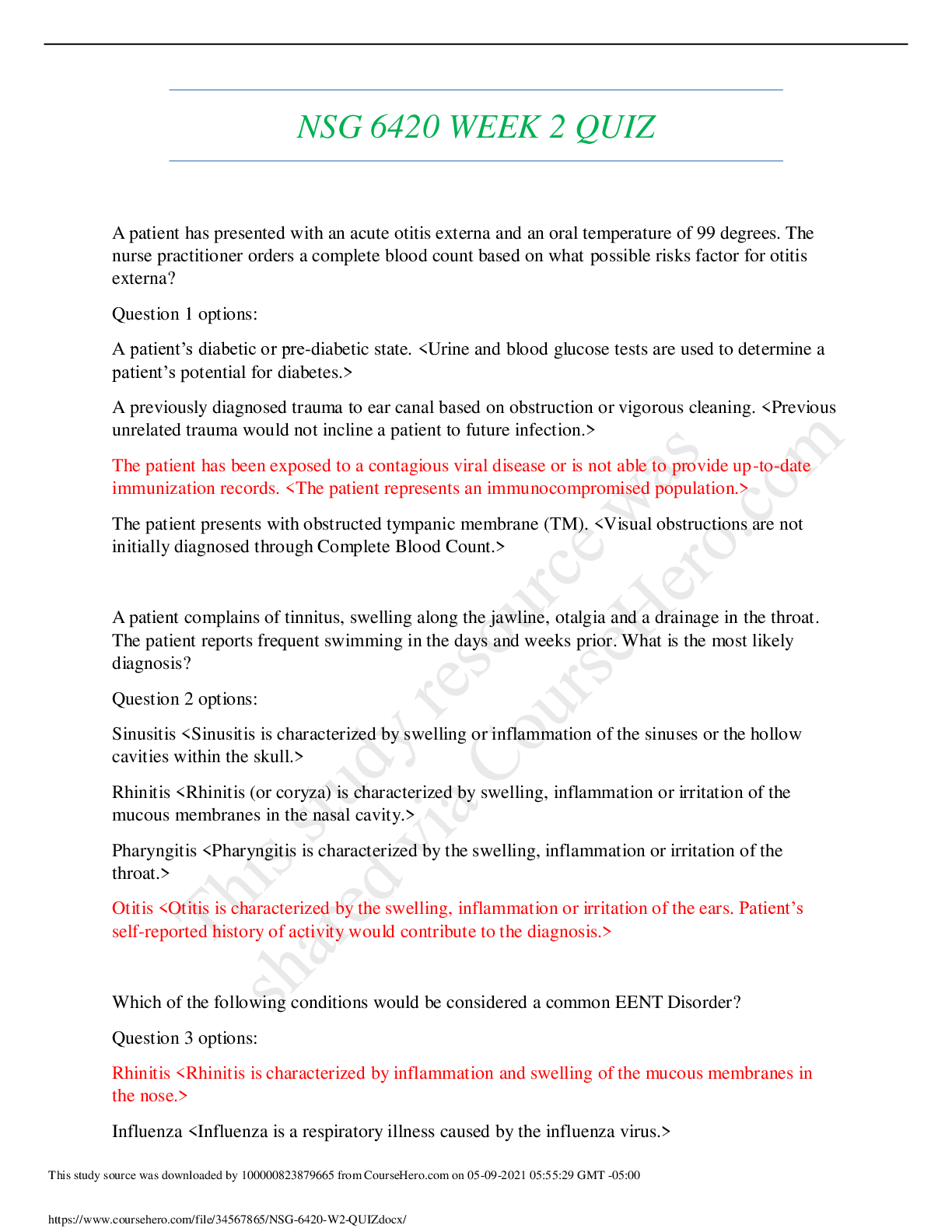
Buy this document to get the full access instantly
Instant Download Access after purchase
Buy NowInstant download
We Accept:

Also available in bundle (1)
Click Below to Access Bundle(s)

NSG 6420 QUIZ 1, 2 and 3 (Q&A with Rationales) | TEST BANK STUDY GUIDE by Kennedy Malone: Advanced Practice Nursing in the Care of Older Adults ;100% CORRECT ;South University
NSG 6420 QUIZ 1, 2 and 3 (Q&A with Rationales) | STUDY GUIDE by Kennedy Malone: Advanced Practice Nursing in the Care of Older Adults ;100% CORRECT ;South University
By Prof. Goodluck 4 years ago
$14.5
6
Reviews( 0 )
$7.00
Can't find what you want? Try our AI powered Search
Document information
Connected school, study & course
About the document
Uploaded On
May 09, 2021
Number of pages
5
Written in
All
Additional information
This document has been written for:
Uploaded
May 09, 2021
Downloads
0
Views
127

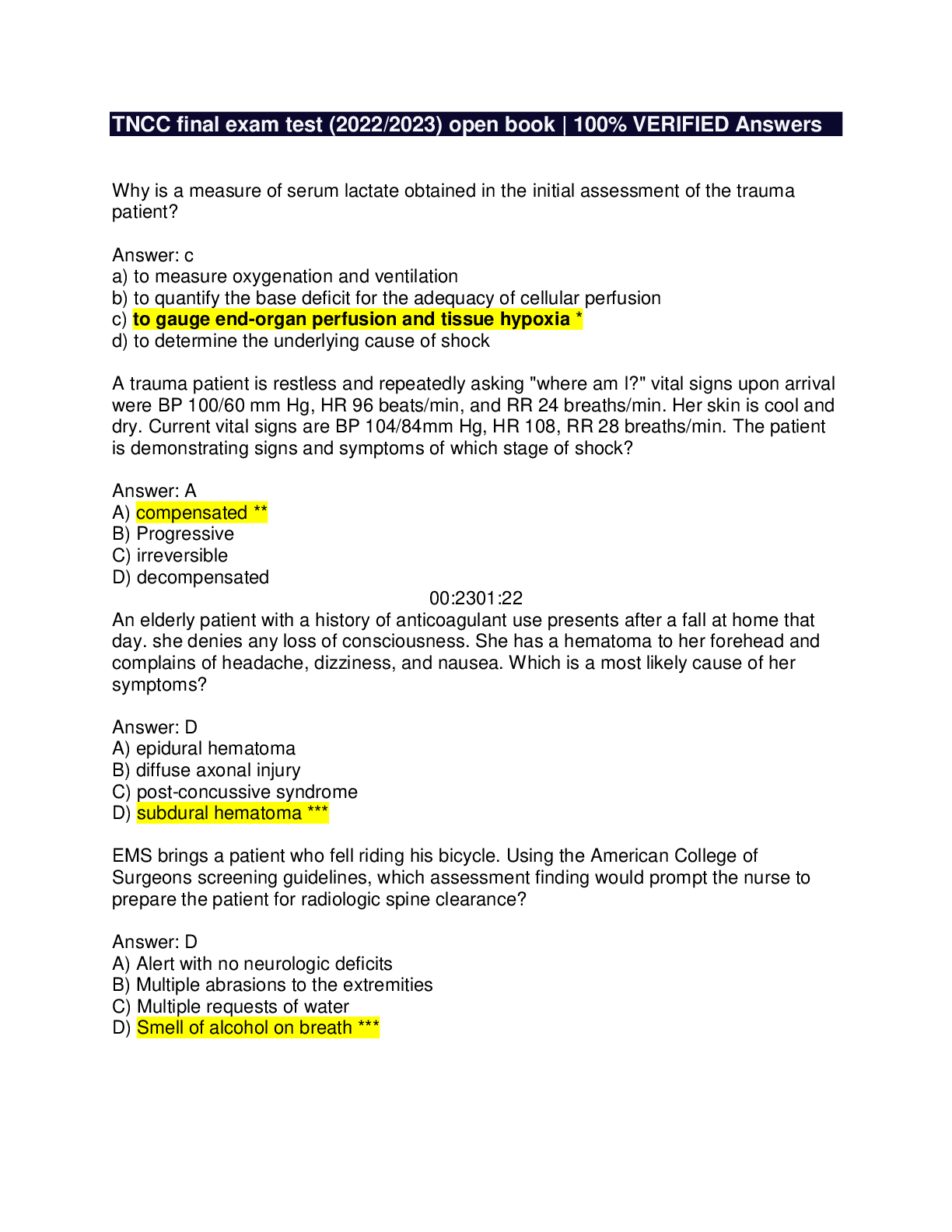
 And LETRS Unit 8 Final Assessment Test.png)










